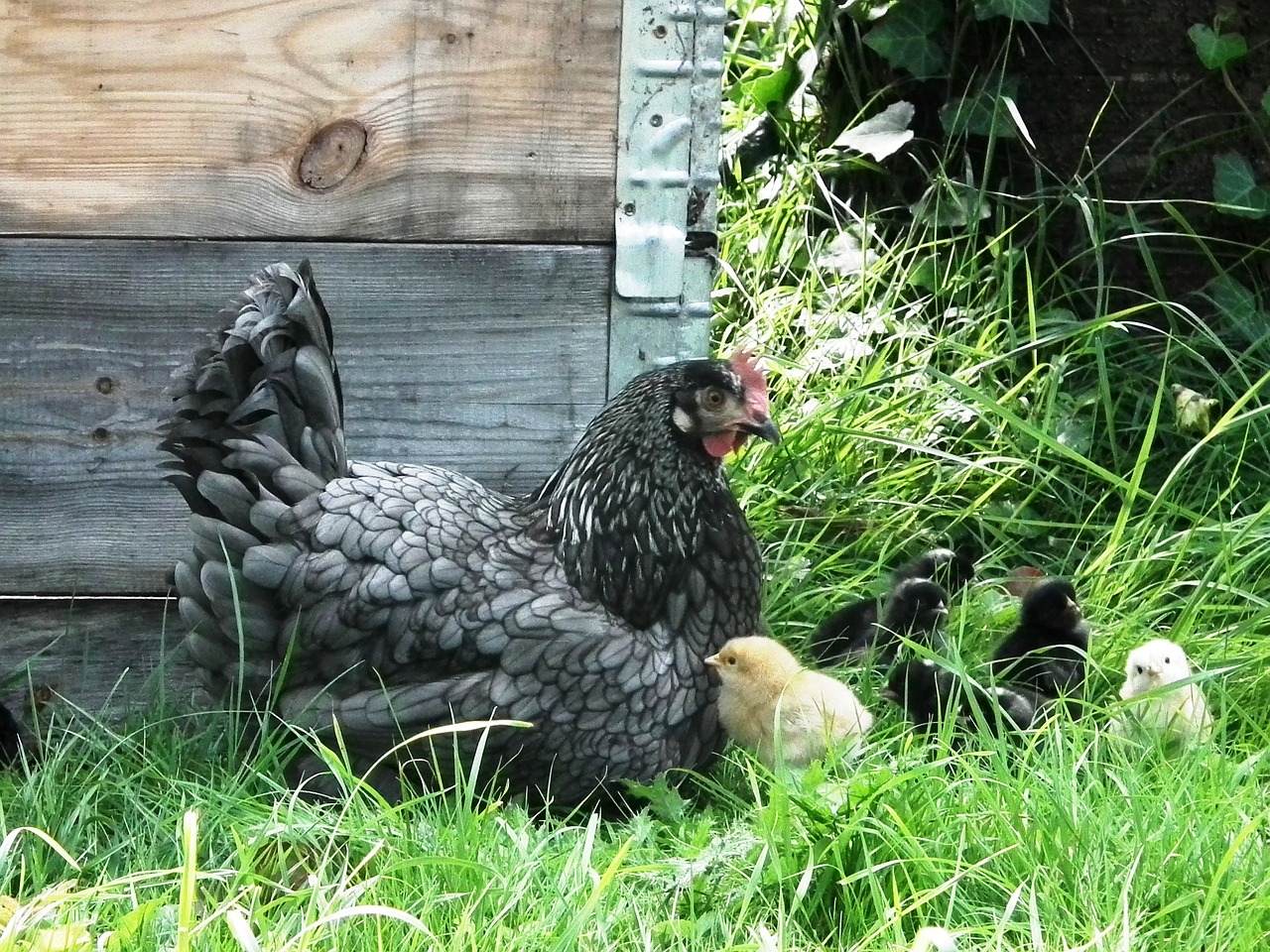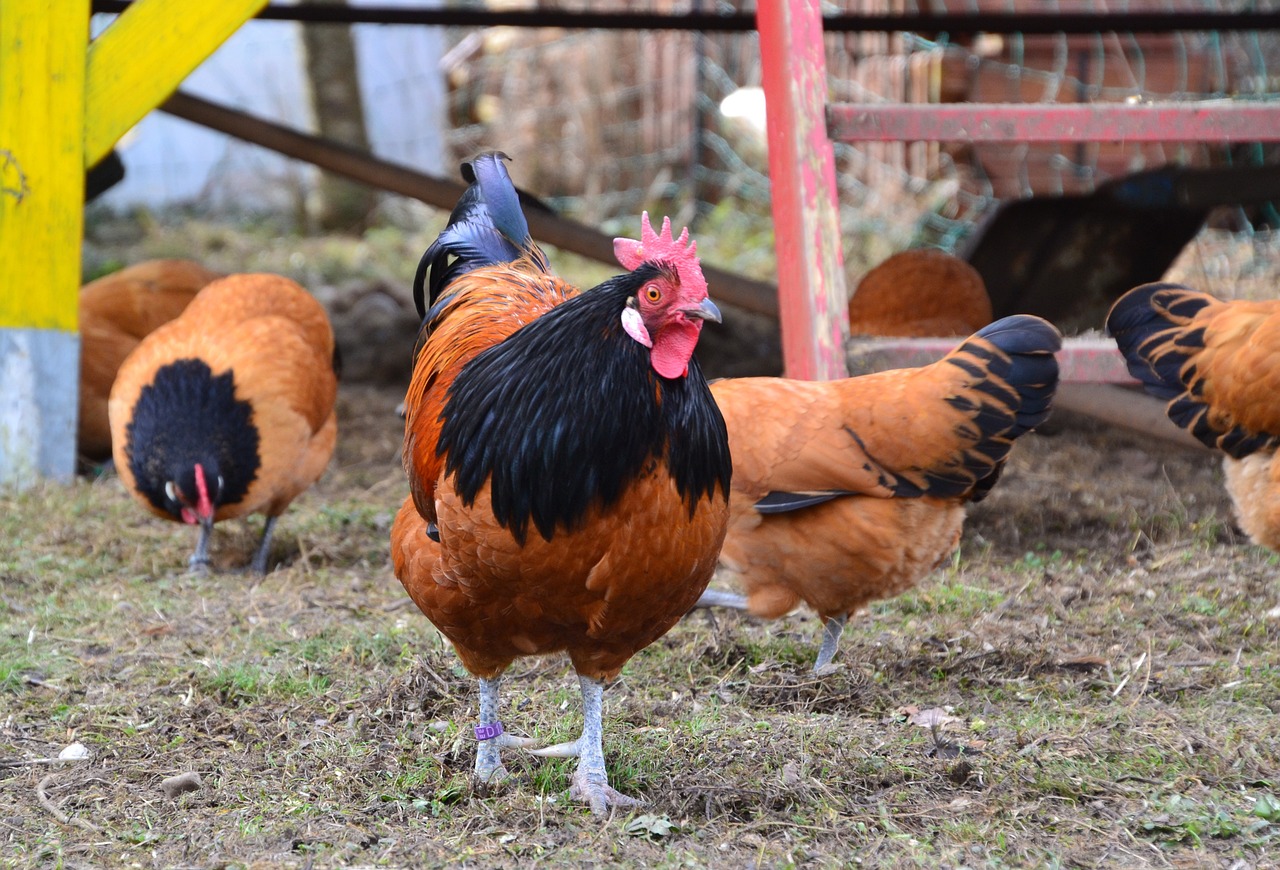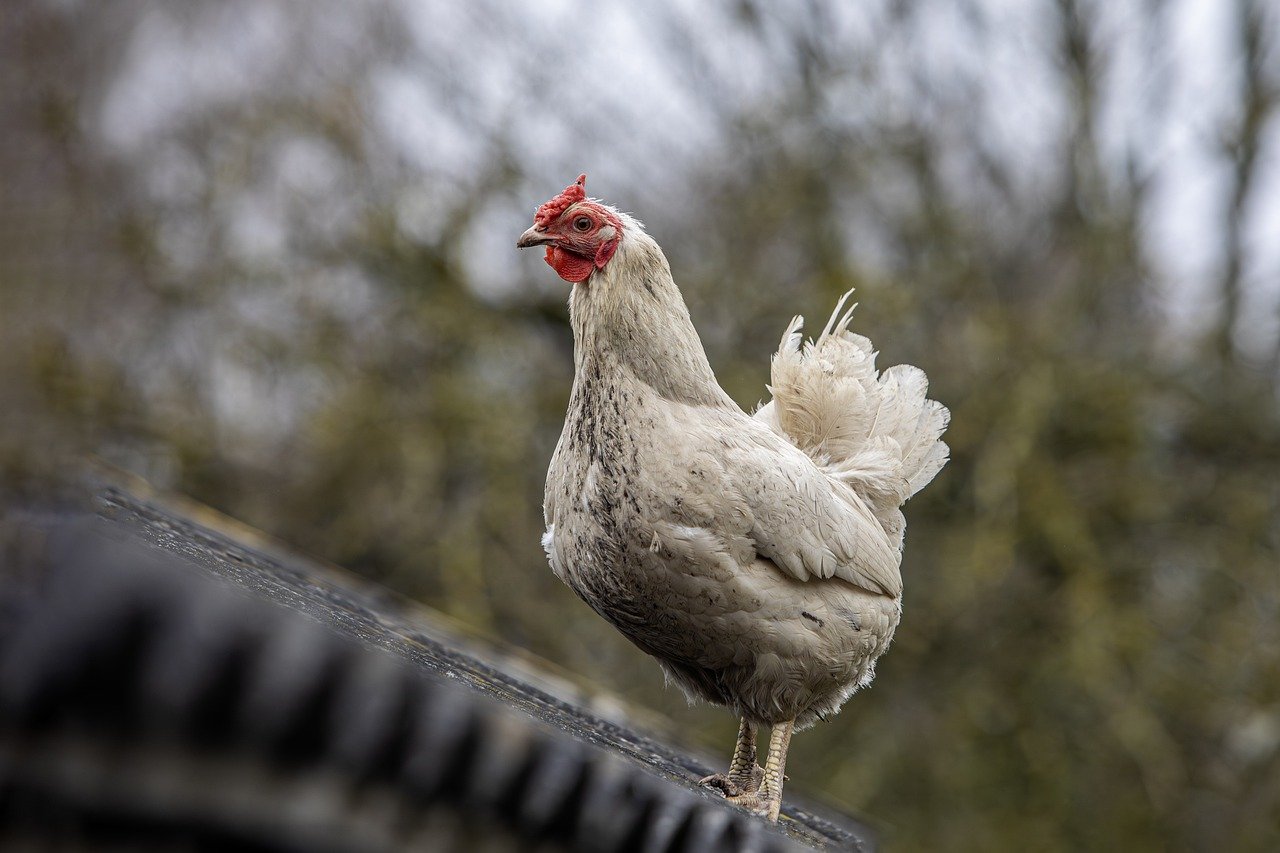How to Raise Backyard Chickens Sustainably
Raising backyard chickens can be an incredibly rewarding experience, not just for the delicious, fresh eggs they provide but also for the joy and companionship they bring. However, the key to making this venture sustainable lies in understanding the best practices that benefit both the chickens and the environment. Imagine stepping into your backyard, greeted by the gentle clucking of your feathered friends, knowing that you are contributing to a healthier ecosystem. In this article, we’ll explore practical methods for raising chickens sustainably, focusing on their care, habitat, and the environmental benefits of keeping chickens in your backyard.
When it comes to sustainability, selecting the appropriate chicken breeds is crucial. Not all chickens are created equal, and some are better suited for your specific climate and lifestyle. For instance, if you live in a colder region, breeds like the Plymouth Rock or Rhode Island Red can thrive in lower temperatures, while those in warmer climates might prefer Leghorns or Orpingtons. Additionally, consider factors such as:
- Egg Production: Some breeds are prolific layers, producing up to 300 eggs a year, while others may only lay a few.
- Temperament: Friendly breeds like Silkies can be great for families, while others may be more skittish.
- Space Requirements: Different breeds have varying needs for space, particularly if you plan to let them roam free.
By carefully selecting the right breed for your environment and lifestyle, you set the foundation for a sustainable chicken-raising experience.
A well-designed chicken coop is not just a shelter; it’s a sanctuary for your flock. The right coop enhances the health and well-being of your chickens while promoting sustainable practices. When building your coop, consider using eco-friendly materials such as reclaimed wood, which not only reduces waste but also gives your coop a rustic charm. Additionally, incorporating designs that allow for natural behaviors—like dust bathing and scratching—can keep your chickens happy and healthy.
Understanding the ideal location and space needs for your chickens is essential. Chickens require proper ventilation to avoid respiratory issues, and they thrive in environments with plenty of sunlight. A good rule of thumb is to provide at least 4 square feet per chicken inside the coop and 10 square feet in an outdoor run. This space allows them to roam freely, reducing stress and promoting natural behaviors.
Incorporating natural light into your coop design can significantly improve chicken health. Chickens need sunlight to produce vitamin D, which is crucial for their overall well-being. Consider adding windows or skylights in your coop design to ensure that sunlight reaches your flock throughout the day. This not only enhances their mood but also encourages egg production.
Using renewable resources in your coop construction can minimize environmental impact. Materials such as bamboo, recycled metal, and even straw bales can be excellent choices. Not only do these materials benefit the planet, but they can also create a cozy environment for your chickens. Additionally, implementing rainwater collection systems can provide a sustainable water source for your flock.
Sustainable feeding practices are vital for the health of your chickens and the environment. Opting for organic feed options reduces the risk of chemical exposure while supporting local farmers. Moreover, supplementing your chickens' diet with kitchen scraps—like vegetable peels and stale bread—can reduce waste and provide your chickens with a varied diet. Just be sure to avoid feeding them anything toxic, such as onions or chocolate!
Proper waste management is key to sustainable chicken raising. Chicken manure is a goldmine for gardeners, rich in nitrogen and other nutrients. Instead of simply disposing of it, consider composting techniques that can turn this waste into nutrient-rich fertilizer for your garden. By implementing a composting system, you not only reduce waste but also enrich your soil, creating a cycle of sustainability.
Learn how to compost chicken manure effectively to create nutrient-rich fertilizer. The key to successful composting lies in balancing carbon and nitrogen. A good ratio is about 30:1 carbon to nitrogen. You can achieve this by mixing straw or dried leaves (carbon) with chicken manure (nitrogen). Additionally, turning your compost regularly helps aerate it, speeding up the decomposition process.
Managing odors and pests sustainably is essential for a healthy backyard. Discover natural methods to keep your coop clean and free from unwanted visitors. Using diatomaceous earth can help control pests, while regularly cleaning the coop and ensuring good ventilation can minimize odors. Consider planting herbs like mint or lavender around the coop; these not only smell great but can also deter pests.
Q: How much space do I need for my chickens?
A: It's recommended to provide at least 4 square feet per chicken in the coop and 10 square feet in an outdoor run.
Q: Can I feed my chickens kitchen scraps?
A: Yes, but avoid toxic foods like onions, chocolate, and citrus fruits. Stick to vegetable peels and stale bread.
Q: How often should I clean the chicken coop?
A: Regular cleaning is important; aim for at least once a week, with more frequent cleanings in warmer months to manage odors.

Choosing the Right Chicken Breeds
Choosing the right chicken breeds is like picking the perfect partner for a dance; it requires understanding, compatibility, and a bit of instinct. When embarking on your chicken-raising journey, you want to consider several key factors that will not only ensure the happiness of your feathered friends but also contribute to the sustainability of your backyard farm. First and foremost, think about your local climate. Some breeds thrive in warmer temperatures, while others are more suited to cooler environments. For instance, if you live in a hot area, breeds like the Leghorn or Red Ranger are known for their heat tolerance. Conversely, if you’re in a cooler region, consider breeds like the Rhode Island Red or Plymouth Rock, which are more resilient to cold weather.
Next, let’s talk about egg production. If your primary goal is to have a steady supply of fresh eggs, you’ll want to choose breeds that are prolific layers. For example, the White Leghorn is famous for its high egg production, laying around 300 eggs per year! On the other hand, if you’re looking for a dual-purpose breed that provides both meat and eggs, the Orpington or Australorp might be your best bet. These breeds are not only good layers but also grow to a decent size for meat production.
Another critical aspect to consider is the temperament of the chickens. Some breeds are known for being friendly and sociable, making them great companions for families, while others can be more skittish or aggressive. If you have children or are looking for a pet-like experience, breeds such as the Silkie or Buff Orpington are typically known for their gentle nature and friendly disposition. On the flip side, if you’re looking for a breed that’s a bit more independent, the Game Hen might fit the bill.
To summarize, here’s a quick table to help you visualize the different factors to consider when choosing chicken breeds:
| Breed | Climate Adaptability | Egg Production | Temperament |
|---|---|---|---|
| Leghorn | Hot | High | Active |
| Rhode Island Red | Cool | Moderate | Friendly |
| Orpington | Moderate | Good | Gentle |
| Silkie | Moderate | Low | Very Friendly |
Ultimately, the right chicken breed for you will depend on your specific needs and circumstances. It’s all about finding that perfect match that not only fits your lifestyle but also thrives in your environment. Remember, raising chickens is not just about producing eggs or meat; it’s about creating a sustainable ecosystem that benefits both you and your chickens. So take your time, do your research, and enjoy the process of becoming a responsible chicken keeper!

Creating a Sustainable Chicken Coop
Building a sustainable chicken coop is much more than just a shelter; it’s about creating a thriving ecosystem for your feathered friends. A well-designed coop not only enhances the health and happiness of your chickens but also contributes positively to the environment. Think of it as a home where your chickens can roam, scratch, and lay eggs while minimizing your ecological footprint. So, how do you transform a simple structure into a sustainable haven for your flock?
First and foremost, consider the materials you use. Opting for eco-friendly materials like reclaimed wood, recycled metal, or even bamboo can significantly reduce your coop's environmental impact. Not only are these materials sustainable, but they also add character to your coop. Imagine a cozy coop made from reclaimed barn wood; it’s not just a shelter, it’s a story waiting to be told!
Next, let’s talk about the design. A sustainable chicken coop should promote natural behaviors. Chickens love to scratch, peck, and dust bathe, so incorporating features that encourage these activities is essential. For instance, a well-ventilated area allows for fresh air circulation, which is crucial for their health. You might consider adding a dust bath area filled with sand and diatomaceous earth, giving them a natural way to keep pests at bay while having fun!
Choosing the right location for your chicken coop is vital. You want to ensure that your coop receives plenty of natural sunlight, as it helps regulate your chickens’ laying cycles and keeps them healthy. Aim for at least 4-6 hours of direct sunlight each day. Furthermore, providing adequate space is crucial. The general rule of thumb is to allow at least 4 square feet per chicken inside the coop and 10 square feet per chicken in an outdoor run. This space not only keeps them comfortable but also reduces stress and aggression among your flock.
When designing your coop, consider incorporating windows or skylights to maximize natural light. Not only will this enhance your chickens’ well-being, but it will also reduce your reliance on artificial lighting. You can use plexiglass panels or even old windows to create a bright and inviting space. Just ensure that the openings are covered with wire mesh to keep predators out while allowing sunlight to pour in.
Using renewable resources in your coop construction can significantly minimize your environmental impact. Consider installing a rainwater collection system to gather water for your chickens, which can be used for drinking or cleaning. Additionally, you can use solar panels to power lights or small fans in the coop, making your setup even more sustainable. Imagine your coop running on sunshine and rain—now that’s the dream!
Lastly, don’t forget about insulation. A well-insulated coop keeps your chickens warm in winter and cool in summer, reducing the need for additional heating or cooling. You can use natural materials like straw bales or even recycled denim insulation. This not only keeps your chickens comfortable but also contributes to energy efficiency.
In summary, creating a sustainable chicken coop involves thoughtful planning and design. By selecting eco-friendly materials, maximizing natural light, and utilizing renewable resources, you can create a space that benefits both your chickens and the environment. Remember, the goal is to create a home that allows your chickens to thrive while also being a responsible steward of the planet.
Q: How much space do I need for my chickens?
A: Generally, you should provide at least 4 square feet per chicken inside the coop and 10 square feet per chicken in the outdoor run.
Q: What materials are best for building a chicken coop?
A: Eco-friendly materials such as reclaimed wood, recycled metal, and bamboo are excellent choices for building a sustainable chicken coop.
Q: How can I ensure my chickens get enough sunlight?
A: Position your coop in a location that receives at least 4-6 hours of direct sunlight each day, and consider adding windows or skylights for natural light.
Q: What are some ways to reduce waste in my chicken coop?
A: Implementing a composting system for chicken manure and using kitchen scraps as feed can help manage waste effectively.

Location and Space Requirements
When it comes to raising backyard chickens sustainably, understanding their is absolutely essential. Chickens are not just simple creatures; they thrive in environments that cater to their natural instincts and behaviors. Imagine a cozy nook in your backyard where your feathered friends can roam freely, bask in the sun, and scratch around in the dirt. This is the kind of setup that not only keeps your chickens happy but also contributes to their overall health and productivity.
First off, let’s talk about the space needs. Ideally, each chicken should have at least 4 square feet of space inside the coop and 10 square feet in an outdoor run. This may seem like a lot, but when you think about it, it allows them to move around comfortably, peck at the ground, and engage in their natural behaviors. If you pack them into a tiny coop, you’re not just risking their happiness; you’re also setting the stage for stress and potential health issues. Nobody wants cranky chickens, right?
Next, let’s dive into the importance of ventilation. Chickens produce a lot of moisture and ammonia, which can lead to a stinky and unhealthy environment if not managed properly. A well-ventilated coop helps to keep the air fresh and reduces the risk of respiratory issues in your flock. Aim for windows or vents that can be opened and closed as needed, allowing for a constant flow of fresh air. Think of it like a breath of fresh air for your chickens—literally!
Now, let’s not forget about sunlight. Chickens love to soak up the sun, and it’s crucial for their well-being. Natural light helps regulate their circadian rhythms, which in turn affects their egg production. When designing your coop, consider placing it in a spot that receives plenty of sunlight throughout the day. You could even incorporate windows or skylights to maximize the light exposure. Just imagine your chickens basking in the warm glow of the sun, clucking happily as they go about their day.
Lastly, think about the surrounding environment. If you have a garden, placing your coop nearby can be a win-win situation. Chickens can help with pest control, and their manure can enrich your soil. However, make sure the area is safe from predators like raccoons and hawks. A sturdy fence and a secure coop are your best friends here. You want your chickens to feel safe and secure, just like you would in your own home!
In summary, providing the right location and space for your chickens is crucial for their happiness and health. By ensuring they have enough room to roam, good ventilation, ample sunlight, and a safe environment, you're setting the stage for a thriving backyard flock. So, roll up your sleeves and get ready to create a chicken paradise right in your backyard!
- How much space do I need for my chickens? Each chicken needs at least 4 square feet inside the coop and 10 square feet in the outdoor run.
- What is the best location for a chicken coop? Choose a spot that gets plenty of sunlight, has good drainage, and is safe from predators.
- How important is ventilation in a chicken coop? Ventilation is crucial to prevent moisture buildup and ammonia odors, contributing to the health of your flock.
- Can chickens live in a small backyard? Yes, but ensure you provide adequate space and enrichment to keep them happy and healthy.

Designing for Natural Light
When it comes to raising chickens, one of the most important yet often overlooked aspects is natural light. Just like us, chickens thrive in environments where they can bask in the sun's warm rays. Natural light is not just a luxury; it’s a necessity for their health and productivity. A well-lit chicken coop can lead to happier, healthier birds, and ultimately, more eggs! So, how can you ensure your coop is flooded with sunlight? Let's dive into some practical tips.
First off, consider the orientation of your coop. Ideally, you want to position it so that the longest side faces south. This way, your coop will receive maximum sunlight throughout the day. If your backyard has trees or buildings that cast shadows, take note of their positions, as they can significantly affect the amount of light your chickens receive. You might even want to think about trimming branches or relocating your coop to a sunnier spot if necessary.
Next, the windows you choose can make a world of difference. Installing large, strategically placed windows can create a bright environment. Not only do windows allow natural light to pour in, but they also provide ventilation, which is essential for keeping your chickens comfortable. You might opt for polycarbonate panels or even plexiglass for durability and insulation. Just remember to ensure that the windows are covered with a screen to keep out predators while allowing light in.
Another innovative idea is to incorporate skylights into your coop design. These can be especially beneficial in smaller coops where wall space is limited. Skylights can provide direct sunlight from above, helping to maintain a warm and inviting atmosphere. Just make sure to use materials that can withstand the elements and prevent overheating during the summer months.
It's also vital to consider the roof design. A sloped roof can help with water drainage and can also be designed to maximize sunlight exposure. You might even want to look into green roofs, which not only provide insulation but can also be a great way to grow plants that attract beneficial insects.
Finally, remember that artificial lighting can supplement natural light, especially during the darker winter months. Using energy-efficient LED lights can mimic natural daylight and help maintain your chickens' laying cycles. Just be sure to provide a natural light-dark cycle, as chickens need their rest too!
By focusing on these design elements, you can create a coop that not only meets the needs of your chickens but also enhances their overall well-being. After all, a happy chicken is a productive chicken!
- How much natural light do chickens need? Chickens ideally need at least 14-16 hours of light per day to maintain optimal egg production.
- Can I use artificial light instead of natural light? Yes, but it’s best to use it in conjunction with natural light to mimic a natural day-night cycle.
- What are the best materials for coop windows? Polycarbonate and plexiglass are excellent choices as they are durable and provide good insulation.

Utilizing Renewable Resources
When it comes to raising chickens sustainably, one of the most impactful steps you can take is in the construction and maintenance of your chicken coop. Not only does this approach minimize your environmental footprint, but it also creates a healthier habitat for your feathery friends. Imagine building a cozy home for your chickens using materials that are both eco-friendly and efficient. It’s like giving them a luxurious suite while being kind to Mother Earth!
First off, consider using reclaimed wood for your coop. This not only saves trees but also adds character and charm to your structure. Reclaimed wood is often more durable than new wood because it has already weathered the elements. Plus, it’s a fantastic conversation starter when friends come over to admire your backyard setup. If you’re handy with tools, you could even turn old pallets into a stylish coop. Just remember to check for any chemicals that might have been used on them.
Another renewable resource to consider is straw or hay for bedding. These materials are biodegradable and can be composted after use, contributing to a sustainable cycle of waste management. Using straw not only keeps your coop smelling fresh but also provides insulation during colder months, ensuring your chickens remain comfortable. If you want to take it a step further, you can even grow your own straw or hay, making your chicken care even more self-sufficient!
Don't forget about solar energy. Installing solar panels on your coop can provide a renewable energy source for lights and heating systems, reducing your reliance on non-renewable energy sources. Imagine basking in the glow of solar-powered lights while your chickens roost peacefully in their coop. It’s a win-win situation that benefits both you and your flock.
Furthermore, consider incorporating rainwater harvesting systems. A simple barrel can collect rainwater from your coop’s roof, providing a sustainable water source for your chickens. This not only conserves water but also ensures that your chickens have access to clean, fresh water without the need to draw from municipal sources. Just be sure to keep the water barrel covered to prevent mosquito breeding!
Lastly, the use of natural insulation materials like straw bales or recycled denim can help regulate temperature in your coop. These materials are not only sustainable but also effective in keeping the coop warm in winter and cool in summer. By creating a comfortable living environment, you’re ensuring that your chickens stay healthy and productive, which is the ultimate goal of sustainable chicken raising.
In conclusion, utilizing renewable resources in your chicken coop is not just about being eco-friendly; it’s about creating a sustainable system that benefits your chickens, your garden, and the planet. Every small step you take can lead to a significant positive impact, so why not start today? Your chickens will thank you, and you’ll feel great knowing you’re doing your part for the environment!

Feeding Chickens Sustainably
Feeding your chickens sustainably is not just a responsibility; it's a rewarding journey that benefits both your flock and the environment. Imagine your chickens pecking happily in your backyard, producing delicious eggs while you contribute to a healthier planet. But how do you achieve this? The answer lies in understanding their dietary needs and making conscious choices about what you feed them.
First and foremost, consider opting for organic feed. Organic feeds are typically free from synthetic pesticides and fertilizers, which means your chickens are getting a diet that is not only nutritious but also free from harmful chemicals. When choosing organic feed, look for blends that are high in protein, vitamins, and minerals to ensure your chickens remain healthy and productive. A well-balanced diet can significantly enhance egg production and overall well-being.
Another fantastic way to feed your chickens sustainably is by supplementing their diet with kitchen scraps. Chickens are omnivorous and love a variety of foods. You can toss them vegetable peels, stale bread, and even leftover grains. However, it’s essential to avoid feeding them anything that is spoiled or moldy, as this can harm their health. By doing this, not only do you reduce food waste, but you also provide your chickens with a diverse diet that keeps them happy and healthy.
Moreover, incorporating foraging opportunities into your feeding routine can mimic their natural behaviors. Allowing your chickens to roam freely in a safe area lets them scratch and peck at the ground, searching for insects, seeds, and greens. This not only enriches their diet but also reduces your feed costs. Imagine the joy of watching your chickens engage in their natural instincts while you know you are providing them with a sustainable lifestyle!
To give you a clearer idea of what a sustainable chicken diet might look like, here’s a simple breakdown:
| Food Type | Benefits |
|---|---|
| Organic Feed | Nutritious, chemical-free, promotes health |
| Kitchen Scraps | Reduces waste, provides variety |
| Foraged Foods | Encourages natural behavior, reduces feed costs |
Lastly, always ensure that your chickens have access to clean, fresh water. Hydration is crucial for their health and productivity. You might be surprised to learn that chickens can drink a significant amount of water, especially during hot weather. Providing them with a constant supply of clean water not only keeps them hydrated but also aids in digestion and the absorption of nutrients from their food.
Feeding chickens sustainably is a blend of knowledge, creativity, and mindfulness. By choosing organic feeds, supplementing with kitchen scraps, and allowing foraging, you’re not just raising chickens; you’re part of a larger movement towards sustainable living. So, roll up your sleeves, get involved, and enjoy the many benefits of feeding your chickens in a way that respects both their needs and the planet!
- What are the best organic feed options for chickens? Look for feeds that are certified organic and contain a mix of grains, proteins, and essential nutrients.
- Can I feed my chickens fruit and vegetable scraps? Yes, but avoid feeding them anything spoiled or moldy. Stick to fresh scraps for the best health benefits.
- How much water do chickens need? Chickens typically drink about a pint of water per day, but this can increase in hot weather or when they are laying eggs.

Managing Waste Effectively
When it comes to raising backyard chickens, managing waste effectively is not just a matter of keeping your coop clean—it's a crucial aspect of sustainable farming that can significantly benefit your garden and the environment. Chickens produce a substantial amount of waste, which, if managed properly, can be transformed into a valuable resource rather than a nuisance. Think of chicken manure as liquid gold for your garden! It’s rich in nutrients and can enhance soil fertility when composted correctly.
One of the most effective ways to manage chicken waste is through composting. By composting chicken manure, you can create a nutrient-rich fertilizer that will nourish your plants and improve soil structure. But how do you get started? It’s all about finding the right balance between carbon and nitrogen. Chicken manure is high in nitrogen, so you'll want to mix it with carbon-rich materials like straw, dried leaves, or wood shavings. This combination not only helps in breaking down the manure but also keeps odors at bay. Here’s a quick overview of how to compost chicken manure:
| Material Type | Examples | Purpose |
|---|---|---|
| Nitrogen-Rich | Chicken manure, kitchen scraps | Provides essential nutrients |
| Carbon-Rich | Straw, dried leaves, wood shavings | Helps balance nitrogen and absorb odors |
In addition to composting, you can also practice effective waste management by utilizing deep litter systems. This method involves layering bedding material like straw or wood chips on the floor of the coop. As the chickens scratch and move around, their droppings mix with the bedding, creating a composting effect right in the coop. Over time, this deep litter will break down, and you can periodically remove it to enrich your garden soil.
Now, let’s talk about odors and pests—two common issues that can arise from improper waste management. Nobody wants a smelly coop, and attracting pests like flies and rodents is the last thing you want. To combat these issues, you can employ several natural methods. For instance, regularly turning your compost pile can help aerate it and reduce odors. Additionally, using herbs like mint or basil around your coop can deter pests while providing a pleasant aroma. Keeping the coop clean and ensuring proper ventilation are also essential steps in maintaining a healthy environment for your chickens.
In summary, managing chicken waste effectively not only keeps your backyard clean but also enriches your garden and minimizes environmental impact. By composting, utilizing deep litter systems, and employing natural odor and pest control methods, you can turn what might seem like a burden into a sustainable and beneficial practice. So, are you ready to transform your chicken waste into a valuable resource?
- How often should I clean my chicken coop? Ideally, you should clean your coop at least once a week, but daily spot cleaning can help keep odors down.
- Can I use chicken manure directly on my garden? It's best to compost it first, as fresh manure can burn plants due to its high nitrogen content.
- What are some signs that my compost is ready? When it turns dark, crumbly, and has an earthy smell, it's ready to use!

Composting Chicken Manure
Composting chicken manure is not just a great way to manage waste; it's a fantastic opportunity to enrich your garden soil with nutrients that your plants will absolutely love. If you think of chicken manure as "black gold," you're on the right track! This nutrient-rich byproduct can transform your garden, making it healthier and more productive. But how do you compost it effectively? Let's dive into the nitty-gritty of composting chicken manure.
Firstly, a successful composting process requires a balanced mix of carbon and nitrogen. Chicken manure is high in nitrogen, which is essential for plant growth. However, too much nitrogen can lead to an unpleasant odor and can even harm your plants. To create a well-balanced compost pile, you should aim for a carbon-to-nitrogen ratio of about 30:1. This means for every part of chicken manure, you should add about three parts of carbon-rich materials. Good sources of carbon include dried leaves, straw, and shredded paper.
When setting up your compost pile, consider the following key components:
- Location: Choose a well-drained spot that is easily accessible for turning the compost and adding materials.
- Size: Aim for a pile that is at least 3 feet by 3 feet. This size helps maintain heat and moisture.
- Moisture: Keep the pile moist, but not soggy. A good rule of thumb is to aim for the consistency of a wrung-out sponge.
As you add chicken manure to your compost, remember to mix it well with the carbon materials. This aeration is crucial because it helps speed up the decomposition process. You might also want to turn your compost every few weeks to keep it aerated and to promote even breakdown. The heat generated by the microbial activity will kill off any pathogens, making your compost safe to use in your garden.
After a few months, your compost will transform into a dark, crumbly substance that smells earthy rather than foul. This is your cue that it’s ready to use! You can apply this compost to your garden beds, enhancing soil fertility and structure. It’s like giving your plants a nutrient-packed boost, helping them to thrive in ways you never thought possible.
In conclusion, composting chicken manure is a sustainable practice that benefits both your garden and the environment. Not only do you reduce waste, but you also create a rich, organic fertilizer that can help your plants flourish. So, roll up your sleeves, get your compost pile started, and watch as your garden transforms into a lush paradise!
Q: How long does it take for chicken manure to compost?
A: Typically, chicken manure can take anywhere from 3 to 6 months to fully compost, depending on the conditions of your compost pile.
Q: Can I use fresh chicken manure in my garden?
A: It's best to compost chicken manure first. Fresh manure can be too strong and may burn your plants.
Q: What should I avoid adding to my compost pile?
A: Avoid adding meat, dairy, and oily foods, as these can attract pests and create odors.

Reducing Odors and Pests
When it comes to raising backyard chickens, managing odors and pests is not just a matter of comfort; it’s essential for the health of both your chickens and your backyard ecosystem. Imagine stepping into your yard and being greeted by the refreshing scent of nature instead of the unpleasant smells that can arise from chicken coops. By implementing some sustainable practices, you can achieve a clean and pleasant environment while keeping pests at bay.
First off, regular cleaning is your best friend. Aim to clean your coop at least once a week. This doesn't mean a full scrub-down every time; rather, it involves removing soiled bedding and droppings, which can accumulate and contribute to odors. Using materials like straw, wood shavings, or hemp for bedding can help absorb moisture and reduce smells. Plus, these materials can be composted later, turning waste into nutrient-rich fertilizer for your garden.
Another effective method for odor control is the use of natural deodorizers. You can sprinkle diatomaceous earth in the coop, which not only helps absorb odors but also acts as a natural pest deterrent. This fine powder is made from fossilized algae and is safe for chickens. Additionally, consider using herbs like mint or rosemary in the coop; their natural fragrances can help mask unpleasant smells while also repelling some pests.
Speaking of pests, keeping your coop well-ventilated plays a significant role in deterring unwanted critters. Proper airflow reduces humidity, which can attract flies and other pests. Ensure that your coop has adequate ventilation by incorporating windows or vents that can be opened during warmer months. You might also want to consider installing a fly trap outside the coop to catch any pesky insects before they become a nuisance.
Furthermore, be mindful of how you store chicken feed. Rodents and other pests are often attracted to open feed containers. Use airtight containers to keep feed fresh and pest-free. If you notice any signs of pests, such as droppings or chewed packaging, act quickly to eliminate them. Traps can be an effective method for controlling rodent populations, but always opt for humane solutions whenever possible.
Lastly, encourage the presence of natural predators in your yard. Birds of prey, such as hawks, can help keep the rodent population in check. You can create a welcoming environment for these beneficial animals by providing safe perches or nesting boxes in your trees. Just be cautious, as you’ll want to ensure your chickens are safe from larger predators as well.
By following these sustainable practices, you will not only reduce odors and pests in your backyard but also create a healthier environment for your chickens. Maintaining a clean and pleasant coop is a win-win for both you and your feathered friends!
- How often should I clean my chicken coop? It's best to clean your coop at least once a week to prevent odors and pests.
- What natural products can I use to deodorize my coop? Diatomaceous earth, herbs like mint and rosemary, and regular bedding changes can help control odors.
- How can I prevent pests from entering the coop? Store chicken feed in airtight containers, maintain good ventilation, and consider using traps for rodents.
- Are there any natural predators I can encourage? Yes, birds of prey like hawks can help control rodent populations in your yard.
Frequently Asked Questions
- What are the best chicken breeds for beginners?
For those just starting out, breeds like Rhode Island Reds and Leghorns are fantastic choices. They’re hardy, easy to care for, and great layers. Plus, they adapt well to various climates, making them perfect for backyard flocks!
- How much space do chickens need in a coop?
Chickens need about 4 square feet per bird inside the coop and 10 square feet per bird in an outdoor run. This ensures they have enough room to move around comfortably, which is essential for their health and happiness.
- Can I feed chickens kitchen scraps?
Absolutely! Chickens love kitchen scraps, and it’s a great way to reduce waste. Just make sure to avoid feeding them anything toxic like onions or chocolate. Think of it as a little treat that helps both you and your feathered friends!
- How do I manage chicken waste sustainably?
Managing chicken waste can be simple! You can compost their manure to create nutrient-rich fertilizer for your garden. Just mix it with carbon sources like straw or leaves, and you'll have a fantastic compost in no time!
- What should I do about pests in the chicken coop?
To keep pests at bay, consider using natural deterrents like diatomaceous earth or essential oils. Regular cleaning and proper ventilation also help keep your coop pest-free. It’s all about maintaining a clean and inviting environment for your flock!
- How can I ensure my chickens get enough natural light?
Incorporating windows or skylights in your coop design is key! Aim for at least 10-12 hours of natural light each day. This not only keeps your chickens happy but also boosts their egg production!
- Is it necessary to use organic feed for my chickens?
While it’s not strictly necessary, using organic feed can greatly benefit your chickens' health and the quality of their eggs. Plus, it’s a sustainable choice that aligns perfectly with raising chickens in an eco-friendly manner!
- How often should I clean the chicken coop?
Cleaning your coop regularly is essential. Aim for a thorough cleaning at least once a month, with spot cleaning weekly. This helps prevent odors and keeps your chickens healthy and happy!



















